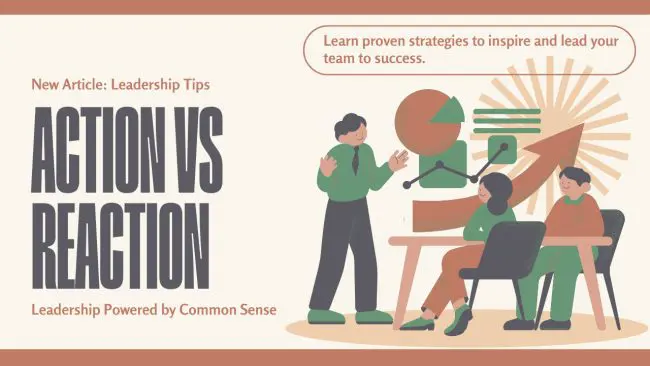Leading the Charge: Action vs. Reaction in Leadership Directives

When it comes to being a great Leader, power of words can tip the scales between proactive dynamism and knee-jerk reactivity. A leader’s directives, those crucial pronouncements that guide and motivate, hold the potential to ignite transformative action or trigger a defensive scramble. Understanding the difference between these two outcomes is fundamental to fostering a team that thrives on initiative and ownership.

Action-oriented directives are like lighthouses in a fog, illuminating the path forward and empowering immediate movement. They are characterized by:
- Clarity and focus: Precise goals and achievable objectives replace ambiguity. Instead of saying, “Improve customer satisfaction,” a leader might specify, “Increase repeat purchase rates by 10% within the next quarter.”
- Ownership and autonomy: Directives inspire independent action by delegating the “how” while outlining the “what.” Rather than dictating specific steps, a leader might empower the team with, “Develop a creative campaign to boost customer engagement.”
- Positive framing: Focusing on potential and opportunity replaces fear and negativity. Instead of saying, “Avoid another financial misstep,” a leader might frame it as, “Let’s optimize spending to unlock new Growth opportunities.”
- Urgency and immediacy: Directives instill a sense of “now” without becoming micromanaging. Phrases like “Let’s hit the ground running on this” or “Time is of the essence” inject a sense of purpose and momentum.
Reaction-inducing directives, on the other hand, can inadvertently create a culture of fear, dependence, and stifled creativity. They are often marked by:
- Vagueness and ambiguity: Directives lack clear direction, leaving teams unsure of their purpose and next steps. A statement like, “We need to be more competitive” leaves the team grappling with “how” without a starting point.
- Control and micromanagement: Directives dictate step-by-step procedures, stifling initiative and independent thought. Instead of empowering the team, a leader might say, “Follow this exact schedule and script to contact clients.”
- Criticism and negativity: The focus is on past mistakes or potential pitfalls, breeding Anxiety and demotivation. Phrases like, “Don’t repeat the last campaign’s blunders” or “We can’t afford another slip-up” shift the emphasis to avoiding failure rather than achieving success.
- Delayed or passive language: Directives lack urgency and leave room for procrastination. Statements like, “We should eventually consider…” or “It might be worth looking into…” fail to ignite immediate action.
What is the Fix? Five Things You Can Do
So, how can leaders shift the paradigm towards action-oriented directives? Being the better Leader requires your own behavioral change. Sometimes easier said than done. However, here are five key strategies to give you a jump start to success:
Start with “Why”:
Before outlining the “what,” explain the purpose and bigger picture. Connecting tasks to a meaningful vision fuels intrinsic motivation and drives ownership.
When a leader starts with “why” before outlining the “what,” they tap into several powerful psychological mechanisms that can have a significant impact on team motivation, engagement, and performance. Here’s a breakdown of the key psychological effects:
Increased Intrinsic Motivation:
- Autonomy: Starting with “why” gives people a sense of control and purpose. It explains the bigger picture and allows them to understand how their individual efforts contribute to something larger than themselves. This fuels intrinsic motivation, the desire to act based on personal values and interests rather than external rewards or pressure.
- Competence: Understanding the “why” behind a task increases feelings of competence and self-efficacy. People are more likely to engage in a task and persist through challenges when they understand its purpose and believe they can contribute meaningfully.
- Relatedness: Connecting tasks to a shared vision fosters a sense of belonging and community. It allows team members to see how their individual work connects to the collective goal, building stronger bonds and fostering collaboration.
Ask Open-Ended Questions:
Instead of dictating solutions, pose questions that spark creative problem-solving and independent thought. “What innovative approaches can we use to achieve this goal?” empowers the team and fosters collaboration.
Benefits for the Team:
- Boosts Creativity and Innovation: Closed-ended questions limit the scope of thinking, while open-ended ones invite exploration and experimentation. By asking “What innovative approaches can we use?”, you open the door for diverse perspectives and unconventional solutions. Team members feel empowered to share their unique ideas, leading to a broader range of possibilities and higher chances of uncovering a truly groundbreaking solution.
- Fosters Collaboration and Ownership: Dictating solutions fosters a passive, follow-the-leader mentality. Open-ended questions, on the other hand, invite team members to actively participate in the problem-solving process. It becomes a collaborative effort where everyone feels their voice is heard and valued. This shared ownership leads to greater commitment and buy-in for the chosen solution, as it was a collective creation, not a top-down imposition.
- Develops Critical Thinking and Problem-Solving Skills: When posed with a problem, individuals often jump to the first solution that comes to mind. Open-ended questions prompt critical analysis and deeper exploration. The team is forced to consider various factors, weigh alternative approaches, and anticipate potential consequences. This continuous questioning and evaluation hones their problem-solving skills, making them more adept at tackling future challenges independently.
- Increases Confidence and Motivation: Taking ownership of problem-solving fosters a sense of competence and agency. Team members feel trusted to contribute their ideas and see their input making a difference. This boosts their confidence and motivates them to actively engage in future decision-making processes.
Benefits for the Leader:
- Uncovers Hidden Gems and Diverse Perspectives: You might have the “official” solution in mind, but by asking open-ended questions, you open yourself up to discovering hidden gems and perspectives you might have missed. Team members with different experiences and backgrounds can bring unexpected insights and approaches to the table, often leading to better outcomes than your initial idea.
- Improves Decision-Making: A single perspective, even an experienced one, can have blind spots. By encouraging diverse viewpoints through open-ended questions, you gather a richer pool of information and considerations. This leads to more informed and well-rounded decisions that factor in multiple angles and potential repercussions.
- Builds Trust and Respect: Dictating solutions can create a power imbalance and leave team members feeling undervalued. Open-ended questions show that you trust their judgment and value their input. This fosters mutual respect and strengthens the leader-team bond, creating a more positive and collaborative work environment.
- Identifies Knowledge Gaps and Training Needs: Through the answers and discussions sparked by open-ended questions, you can identify areas where team members might lack knowledge or skills. This allows you to tailor training programs and development opportunities to address those gaps, ultimately strengthening your team’s overall capabilities.
Set Boundaries with Trust:
Define parameters for action without micromanaging the process. Providing clear goals and deadlines while allowing autonomy fosters accountability and initiative.
Setting boundaries in leadership might seem counterintuitive, like drawing a map while encouraging exploration. But in reality, it’s a delicate dance between empowerment and accountability, one that fosters initiative and ownership within your team. Here’s how:
Defining Parameters, Not Playbooks:
- Think of boundaries as guardrails, not fences. They outline the playing field without dictating every step. Provide clear goals and objectives, set realistic deadlines, and establish any essential guidelines (e.g., budget constraints, compliance regulations). This gives your team the context and framework they need to operate.
Autonomy as Fuel for Initiative:
- Micromanaging stifles creativity and initiative. Instead, trust your team’s capabilities and grant them the freedom to choose their path within the outlined boundaries. This fosters a sense of ownership over their work, propelling them to go the extra mile and find innovative solutions.
Accountability: The Anchor of Ownership:
- Freedom does not equate to a free-for-all. Accountability ensures everyone stays aligned with the bigger picture. Regular check-ins, progress reports, and open communication provide opportunities to offer guidance, celebrate milestones, and address any potential roadblocks.
Celebrate Progress and Effort:
Recognize and reward not just successful outcomes but also the proactive efforts and creative solutions showcased on the path to achieving them. This reinforces action-oriented behavior and builds confidence.
Celebrating progress and effort goes beyond a simple pat on the back. It’s a strategic tool that weaves a powerful spell of motivation, confidence, and a continuous drive for action within your team. Here’s a closer look at the magic hidden within this seemingly simple act:
Beyond the Finish Line: Recognizing the Stepping Stones:
- Most celebrations reserve the spotlight for the final victory, the champagne popped at the finish line. While acknowledging success is crucial, neglecting the smaller triumphs along the way can demotivate those tirelessly climbing the hill. Instead, celebrate milestones, completed tasks, and incremental progress. Highlighting these mini-achievements keeps the team momentum going, reminding them that every step forward matters.
Effort: The Unsung Hero:
- It’s easy to get caught up in the tangible outcomes, overlooking the blood, sweat, and ingenuity poured into their creation. Celebrating effort, the tireless hours, the brainstorming sessions, and the late-night revisions, sends a powerful message: the journey holds value. This recognition fuels intrinsic motivation, pushing the team to put in their heart and soul even when the finish line feels blurry.
Creative Spark: Applauding the Unconventional:
- Innovation rarely follows a straight line. It dances through detours, takes unexpected turns, and often wears the messy clothes of trial and error. Celebrating creative solutions, even if they don’t lead to immediate success, encourages risk-taking and experimentation. It validates the value of thinking outside the box and emboldens the team to keep exploring beyond the conventional path.
Building the Bridge to Confidence:
- Recognition breeds confidence. When achievements, big and small, and the effort behind them are acknowledged, team members feel valued and capable. This newfound confidence fuels their resilience in the face of challenges and propels them to tackle future hurdles with a bolder stance.
Embrace Mistakes as Learning Opportunities:

Foster a culture of open communication and learning from setbacks. Viewing mistakes as detours instead of dead ends encourages risk-taking and experimentation, both crucial for progress.
Ultimately, the shift from reaction to action lies in fostering a climate of trust, empowerment, and shared vision. By using clear, positive, and purpose-driven directives, leaders can inspire their teams to embrace initiative, own their actions, and become proactive players in shaping their own success. This is the true mark of transformative leadership, where words don’t just control, but ignite the spark of action that fuels change and propels teams towards their collective goals.
The post Leading the Charge: Action vs. Reaction in Leadership Directives appeared first on Business Advisor and Executive Coach | Doug Thorpe.

























